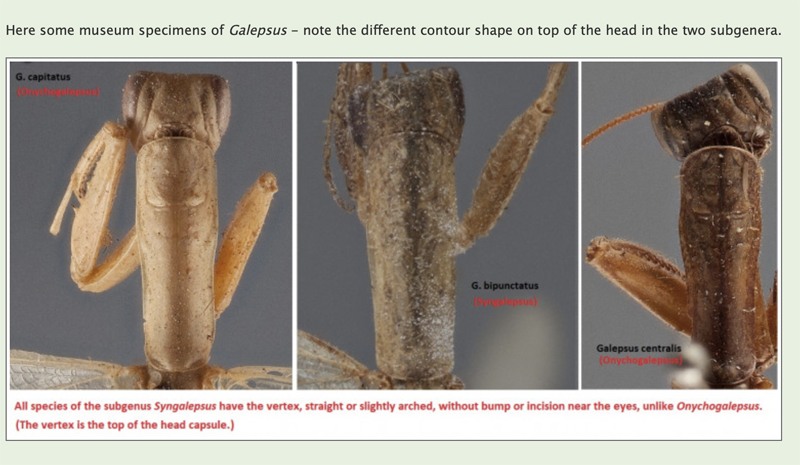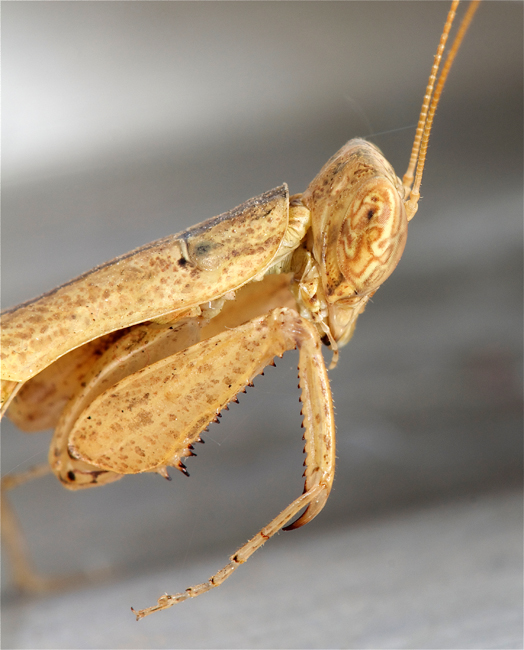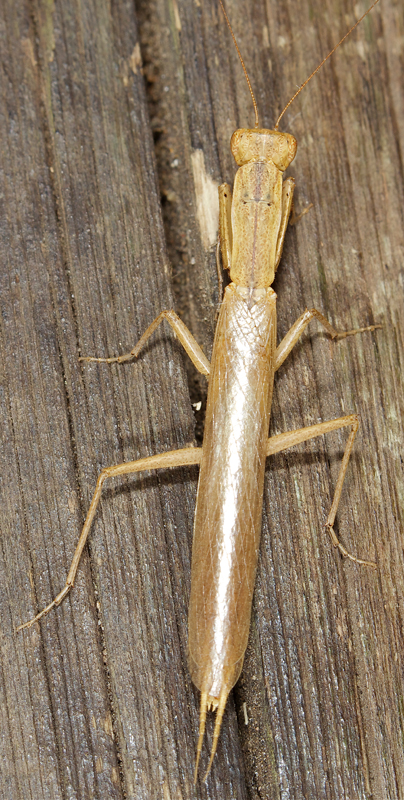Eye shape different, spines on front legs different configuration, and all the Antistia sp. heads look noticeably wider than the thorax, whereas this one is somewhat near the same width as the thorax. ???
Insect or Invertebrates Identification - DONE
Moderator: Klipspringer
Re: Insect or Invertebrates Identification
Re: Kruger spec.
Eye shape different, spines on front legs different configuration, and all the Antistia sp. heads look noticeably wider than the thorax, whereas this one is somewhat near the same width as the thorax. ???
Eye shape different, spines on front legs different configuration, and all the Antistia sp. heads look noticeably wider than the thorax, whereas this one is somewhat near the same width as the thorax. ???
-
Klipspringer
- Global Moderator
- Posts: 5862
- Joined: Sat Sep 14, 2013 12:34 pm
- Country: Germany
- Contact:
Re: Insect or Invertebrates Identification
Have redone the entry
viewtopic.php?p=172658#p172658
We can be proud
-
Klipspringer
- Global Moderator
- Posts: 5862
- Joined: Sat Sep 14, 2013 12:34 pm
- Country: Germany
- Contact:
Re: Insect or Invertebrates Identification
You are spot on, ExFmem - this is another genus (Galepsus) and luckily one with better references available.
Galepsus (Syngalepsus) bipunctatus or Galepsus (Onychogalepsus) intermedius are our contenders, IMO
Here some museum specimens of Galepsus - note the different contour shape on top of the head in the two subgenera.
... and the Kaltenbach figures illustrating the 3 subgenera.
Galepsus is represented by 10 species in South Africa.
Females have reduced wings!
Distribution map:
Galepsus (Syngalepsus) bipunctatus, Galepsus (Onychogalepsus) letabaensis, Galepsus (Onychogalepsus) capitatus and Galepsus (Onychogalepsus) intermedius recorded from KNP.
Links:
https://www.researchgate.net/publicatio ... rachodidae
https://specimens.mantodearesearch.com/specimen/921
https://specimens.mantodearesearch.com/specimen/147
https://www.zobodat.at/pdf/ANNA_100B_0019-0059.pdf
http://mantodea.speciesfile.org/Common/ ... ID=1185281
-
Klipspringer
- Global Moderator
- Posts: 5862
- Joined: Sat Sep 14, 2013 12:34 pm
- Country: Germany
- Contact:
Re: Insect or Invertebrates Identification
Description of Galepsus bipunctatus by Beier
Translation:
Galepsus bipunctatus n. sp. ♂.
Yellowish brown.
Lower frons slightly wider than high.
Vertex slightly rounded, without juxtaocular bulges near the eyes.
Eyes flat, hardly convex on the sides, almost parallel, with a pronounced, narrow rounded upper corner. The vertex without angle merging into the upper edge of the eyes.
Pronotum more than 2.5 times as long as wide, margins almost parallel, scarcely wider at the front than at the back, the lateral pronotal expansion not pronounced.
Prosternum with two rounded, sharp, limited black spots, basal from the middle.
Forewings shorter than abdomen, not coloured. Hindwings not coloured, only the base slightly smoked and slightly iridescent.
Forecoxae monochrome, slightly brown at the base. Trochanter without colour spot. Forefemora yellow, anteroventral femoral spines only dark at the apex. Tibiae and tarsi monochrome. Cerci flat, the distal cercomeri long and narrow, about 4 times as long as wide.
Body length 29 mm, pronotum length 6.8 mm, width of pronotum 2.5 mm, metazone length 4.3 mm, forewing length 18 mm.
__________________________________-
by Kaltenbach:
Translation:
Galepsus bipunctatus n. sp. ♂.
Yellowish brown.
Lower frons slightly wider than high.
Vertex slightly rounded, without juxtaocular bulges near the eyes.
Eyes flat, hardly convex on the sides, almost parallel, with a pronounced, narrow rounded upper corner. The vertex without angle merging into the upper edge of the eyes.
Pronotum more than 2.5 times as long as wide, margins almost parallel, scarcely wider at the front than at the back, the lateral pronotal expansion not pronounced.
Prosternum with two rounded, sharp, limited black spots, basal from the middle.
Forewings shorter than abdomen, not coloured. Hindwings not coloured, only the base slightly smoked and slightly iridescent.
Forecoxae monochrome, slightly brown at the base. Trochanter without colour spot. Forefemora yellow, anteroventral femoral spines only dark at the apex. Tibiae and tarsi monochrome. Cerci flat, the distal cercomeri long and narrow, about 4 times as long as wide.
Body length 29 mm, pronotum length 6.8 mm, width of pronotum 2.5 mm, metazone length 4.3 mm, forewing length 18 mm.
__________________________________-
by Kaltenbach:
Pronotum monochrome - we can rule this one out. The pronotum is speckled and has a dark median line.Galepsus (Onychogalepsus) letabaensis sp.n. (Abb. 41)
Locus typicus: Letaba. E-Transvaal.
Material: Holotypus (d): SÜDAFRIKA: Transvaal: Letaba. K. N. P.. 14.-I8.XI.1961, L. Vari & D. W. Rorke. TMSA.
Diagnose (♂; ç unbekannt): Kopf dieser habituell der G. damaranus-Gruppe sehr ähnlichen Art etwas breiter als lang.
Vorderrand des Vertex in Dorsalansicht fast gerade, in Frontalansicht flach gewölbt, ohne Kerben oder Höcker.
Augen lateral deutlich gerundet.
Frontalschild 1,2mal so breit wie hoch, mit schwach konvex gekrümmtem Dorsalrand.
Temporalregion hinter den Augen ohne schwarzen Fleck.
Pronotum 2,8mal so lang wie breit, einfarbig. Supracoxalerweiterung kaum ausgeprägt, Metazona nur geringfügig verschmälert.
Prosternum, ausgenommen Basis und Vorderrand, geschwärzt.
Elytren 3,1 mal so lang wie das Pronotum, mit breitem Costalfeld, das Abdomen-Ende etwas überragend, semitransparent, Adern bräunlichgelb. Vordercoxae einfarbig, fast ebenso lang wie die Metazona des Pronotum. Vorderbeine lateral und medial mit schwarzen Flecken. Vorderfemora mit schwarzspitzigen Innenranddornen, die z. T. an der Basis geschwärzt sind.
Gesamtfärbung scherbengelb.
-
Klipspringer
- Global Moderator
- Posts: 5862
- Joined: Sat Sep 14, 2013 12:34 pm
- Country: Germany
- Contact:
Re: Insect or Invertebrates Identification
http://biblio.naturalsciences.be/rbins- ... nt-red.pdf
Key for the Onychogalepsus males by Beier
Key for the Onychogalepsus males by Beier
Scheitel vollkommen gerade; Augen meist parallelseitig [vertex perfectly straight; eyes mostly parallel-sided]
--> G. (O) capitatus
Scheitel und Augen leicht, aber deutlich gewölbt; [vertex slightly arched and eyes slightly but clearly convex]
--> G. (0.) intermedius (Pronotum 6 mm, forewings 17 mm long)
-
Klipspringer
- Global Moderator
- Posts: 5862
- Joined: Sat Sep 14, 2013 12:34 pm
- Country: Germany
- Contact:
Re: Insect or Invertebrates Identification
That's all I can find and here my thoughts
What we have: vertex is slightly arched and eyes are convex, shape of pronotum is not almost strait on the margings, but looks like that of intermedius in the Kaltenbach figure.
Based on convex eyes and pronotum, I would say it is rather G. intermedius (but we don't have a decription for that species).




What we have: vertex is slightly arched and eyes are convex, shape of pronotum is not almost strait on the margings, but looks like that of intermedius in the Kaltenbach figure.
Based on convex eyes and pronotum, I would say it is rather G. intermedius (but we don't have a decription for that species).
Re: Insect or Invertebrates Identification
In the photo comparison of the 2 subgenera, Syngalepsus has NO indentations/bumps/incision on the top of the head near the eyes, which are plainly seen in the 2 species of Onychogalepsus.

Mine has none that I can discern - looks quite flat from both the side view of the head and the above view, which would make it G. bipunctatus.





Mine has none that I can discern - looks quite flat from both the side view of the head and the above view, which would make it G. bipunctatus.



-
Klipspringer
- Global Moderator
- Posts: 5862
- Joined: Sat Sep 14, 2013 12:34 pm
- Country: Germany
- Contact:
Re: Insect or Invertebrates Identification
The Beier key reads for both subgenera Syngalepsus and Onychogalepsus:
You are right, the veretx of your mantis is without incisions, bumps etc. But that does not tell apart the subgenera according to Beier's key, it's about vertex straight vs slightly rounded/arched/convex
The other Beier paper quoted above reads for G. bipunctatus
______________________
Beier's key points to the prosternum to tell apart the subgenera:
And for G. bipunctatus:
We don't see the prosternum in your photos?

[vertex straight or slightly rounded, not set off from the dorsal margin of the eyes, without incisions and without bumps]. Scheitel gerade oder leicht gewölbt, vom Dorsalrand der Augen nicht abgesetzt, ohne Einschnitte und ohne Beulen
You are right, the veretx of your mantis is without incisions, bumps etc. But that does not tell apart the subgenera according to Beier's key, it's about vertex straight vs slightly rounded/arched/convex
The other Beier paper quoted above reads for G. bipunctatus
IMO, this does not match, the eyes are not hardly convex almost parallel, but clearly convex.Vertex slightly rounded, without juxtaocular bulges near the eyes.
Eyes flat, hardly convex on the sides, almost parallel, with a pronounced, narrow rounded upper corner.
______________________
Beier's key points to the prosternum to tell apart the subgenera:
The prosternum is the underside (ventral) - you can see it in Kaltenbach's figuresProsternum in der Medianlinie mehr oder weniger breit geschwärzt, ohne Punktmakeln
[prosternum in the median line more or less blackened, without spots]
--> Onychogalepsus
Prosternum mit 2 kreisrunden schwarzen Makeln in der Metazone, mitunter ausserdem in grösserer Ausdehnung geschwärzt
[prosternum with 2 circular spots in the metazone, sometimes also blackened over a large area]
--> Syngalepsus
And for G. bipunctatus:
Prosternum with two rounded, sharp, limited black spots, basal from the middle.
We don't see the prosternum in your photos?
Re: Insect or Invertebrates Identification
I should have known it was too easy to be true. Eish.
“All species of the subgenus Syngalepsus have the vertex, straight or slightly arched, without bump or incision near the eyes, unlike Onychogalepsus.”
I interpreted that to say all Syngalepsus species have straight…unlike Onychogalepsus, i.e. all species DO have that feature. I suppose it was saying some Onychogalepsus do, some don’t. Not very precise wording.
Back to the drawing board….
Thanks for the clarification I'll look to see if I have any pics I didn't process that may show more of the ventral side, but it's unlikely.
I'll look to see if I have any pics I didn't process that may show more of the ventral side, but it's unlikely.
“All species of the subgenus Syngalepsus have the vertex, straight or slightly arched, without bump or incision near the eyes, unlike Onychogalepsus.”
I interpreted that to say all Syngalepsus species have straight…unlike Onychogalepsus, i.e. all species DO have that feature. I suppose it was saying some Onychogalepsus do, some don’t. Not very precise wording.
Back to the drawing board….
Thanks for the clarification
-
Klipspringer
- Global Moderator
- Posts: 5862
- Joined: Sat Sep 14, 2013 12:34 pm
- Country: Germany
- Contact:
Re: Insect or Invertebrates Identification
I was confused, too. I think it means, that all Syngalepsus but not all Onychogalepsus have this vertex 

ExFmem, we agree on the vertex without bumps, but this is a possible character for both subgenera. We have to look at the shape of the eyes and the pronotum
http://biblio.naturalsciences.be/rbins- ... nt-red.pdf
This paper by Max Beier gives an account for the subgenera
ExFmem, we agree on the vertex without bumps, but this is a possible character for both subgenera. We have to look at the shape of the eyes and the pronotum
http://biblio.naturalsciences.be/rbins- ... nt-red.pdf
This paper by Max Beier gives an account for the subgenera


